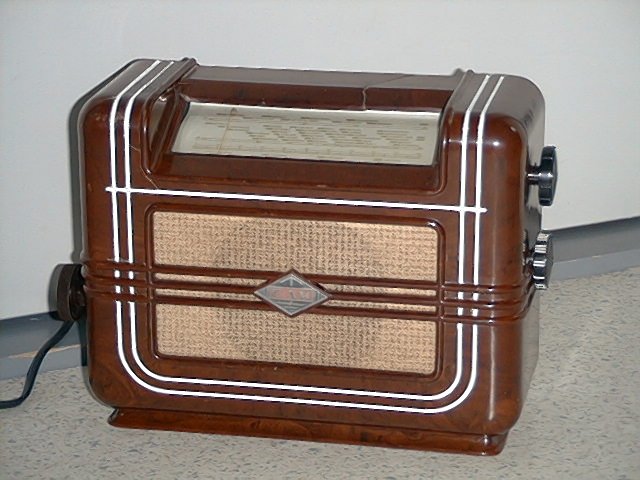
161
Item nr.

EAK Super 64/50 GWP Mini Radio
Small Bakelite mini with six bands.
Data for EAK Super 64/50 GWP
| Production | Germany, 1952.
|
|---|
| Bands | LW (152-300 kHz), MW (520-1700 kHz), 49m, 41m, 31m, 25m (see below). |
|---|
| Tubes | UCH11, UBF11, UEL51 (selenium rectifier). |
|---|
| Cabinet | Bakelite.
Size 28x21x12 cm.
Weight 3.5 kg. |
|---|
| Power | ACDC 220V. |
|---|
The Design
EAK means Elektro-Apparate-Fabrik, Köppelsdorf. Otto reports that the last digits of EAK models are the model year, so the radio was designed in 1950. The letters in German type numbers often indicate power, where G means Gleichstrom (DC) and W means Wechselstrom (AC). Indeed this radio is an ACDC type. The P probably means Pressstoff, for Bakelite; other sets with wood case have an H (for Holz) there. I have a schema for the 64/50 GWS (with UCL11 output; S probably stands for Super) but my radio is GWP and has UEL51, a later tube. The letter T in the type, if present, stands for Trocken or dry rectifier. The radio is equiped with a symbolic dial. For the SW bands the dial gives no frequencies nor stations, but only a ruler from 0 to 100. Except on radios of the twenties and special measuring equipment I had never seen such a setup before. The tubes are special "German" eight and ten pin types, not very commonly found here in The Netherlands. The output tube is the 10 pin UEL51. Rectification is by a big selenium diode, but I bypassed this with a modern silicon type. for safety. The chassis is cast metal and the entire build-up is very cramped so that it is hard to work on it, especially on the AF amplifier.

Frequency Measurements
One often finds receiving frequencies listed for radios, also for the sets in Gerard's Radio Corner. These data are sometimes taken from documentation, but more often they are simply the leftmost and rightmost figures found on the dial. As the EAK lists no frequencies for the shortwave bands, and nobody has full service documentation, its receiving frequencies are a mystery. I measured the actual receiving frequencies for my EAK using the LM13 frequency meter. A rough test with the dipmeter was faster, but the dipmeter is not accurate enough.
| Band | 0 | 33 | 67 | 100 | Length |
|---|
| 25m | 11895
25.22m | 11921
25.16m | 11997
25.01m | 12103
24.79m | 218 kHz |
| 31m | 9583
31.31m | 9614
31.20m | 9708
30.90m | 9856
30.44m | 273 kHz |
| 41m | 7162
41.89m | 7196
41.69m | 7307
41.06m | 7492
40.04m | 330 kHz |
| 49m | 5910
50.76m | 6046
49.62m | 6102
49.16m | 6360
47.17m | 450 kHz |
I measured the frequency of each of the four SW bands at points 0, 33, 67, and 100 of the scale, and computed the length of the band. Of course my radio may receive different frequencies from those intended by the manufacturer, and your set may be different from both again. The accuracy of my measurements is better than 10kHz. Some observations that jump to mind:
(1) Tuning is really very smooth due to bandspread. Even the longest band (450 kHz) is less than half as long as the Medium Wave band.
(2) The frequency is far from linear: stations are more cramped on the high end of the scale than on the low end. This hapens in most radios and I can remark that due to the bandspread tuning is actually quite easy on all SW bands.
(3) The bands of lower frequency are longer (have more kHz in the last column) than the higher frequency bands. This is the other way around in most radios, and I assume this is caused by the inductive tuning used in the EAK.
| Obtained | 9/2000
from Paul van Berlo. |
|---|
| Condition | 6. |
|---|
| Disposed | Sold 10/2004. |
|---|
This Object
The radio worked very poorly initially: only one station could be heard. I gave it a medium electrical overhaul, replacing the leaking capacitors and bypassing the rectifier by a diode. Now it works satisfactorily. The external state was more of a problem. The picture on the left shows the radio when I got it, the right picture shows a similar radio I saw at a flee market. 
 I used Commandant Cleaner for the bakelite and freshened up the white lines with Tipp-Ex. The broken dial was the most problematic, but fortunately Otto supplied me with a sharp scan of the dial. I digitally removed dust and printed it on a transparancy.
I used Commandant Cleaner for the bakelite and freshened up the white lines with Tipp-Ex. The broken dial was the most problematic, but fortunately Otto supplied me with a sharp scan of the dial. I digitally removed dust and printed it on a transparancy.The radio looks a lot better now, and sounds a lot better too, but because of the design I consider it to be among my most unsafe radios and never play it when I'm not in the room. In June 2002 it stopped playing and blew a fuse in my power supply.
Part of Gerard's Radio Corner.
Generated by SiteBuilder on
26/2/2024
by Gerard
(g.tel@uu.nl)





 I used Commandant Cleaner for the bakelite and freshened up the white lines with Tipp-Ex. The broken dial was the most problematic, but fortunately Otto supplied me with a sharp scan of the dial. I digitally removed dust and printed it on a transparancy.
I used Commandant Cleaner for the bakelite and freshened up the white lines with Tipp-Ex. The broken dial was the most problematic, but fortunately Otto supplied me with a sharp scan of the dial. I digitally removed dust and printed it on a transparancy.